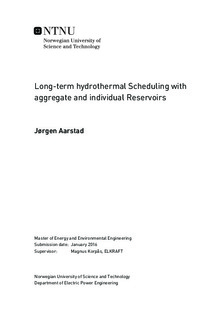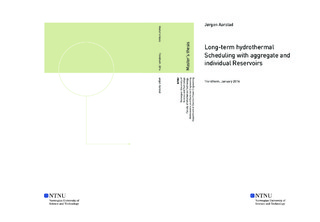| dc.description.abstract | This thesis is a comparative analysis of two commensurable models used in long-term hydrothermal scheduling. The first model is the EMPS model, which is the most prevalent tool for long-term planning in the Norwegian power industry. The second model is known as the SOVN model, which is currently under development at SINTEF Energy Research. A tighter market coupling to the continental European power system with an increasing penetration of intermittent and non-storable renewable energy, requires models that better represent the flexibility of the Nordic hydropower system, since the reservoir aggregation of the EMPS model has proven inadequate to fully handle this. SOVN aims to circumvent this through a detailed simulation of the hydropower system, where the production at each individual power plant is optimized through a complex SLP algorithm using Benders decomposition. Moreover, the SOVN model does not require the same substantial user input as EMPS, which can help minimizing some of the uncertainty of the results.
The first part of this thesis covers the Nordic hydropower system, power system economics and the general framework for long-term hydrothermal scheduling. In the two subsequent chapters the EMPS and SOVN models are thoroughly introduced, both conceptually and mathematically. The analytical part of this thesis is initiated with a review of the case scenarios and power system data: The analysis addresses a confined power system in Northern Norway, where adjacent markets are represented as exogenous price files. The first part of the analysis examines the influence on the performance of SOVN by changing the settings in the SOVN.ctrl file. The remaining analysis investigates the power system in extreme surplus situations, by introducing increased wind power development in the region, given as discrete scenarios between 265 and 4,835 MW installed capacity.
In the most moderate of these cases, the share of unregulated production, i.e. production with zero opportunity cost, in EMPS and SOVN is 28.71% and 7.81%, respectively. With 4,835 MW installed wind energy these shares are increased to 44.06% and 9.28%. That is, not only does SOVN minimize its forced production, it also reduces the impact of surplus situations on its operational liberty. Consequently, spillage in SOVN is also significantly reduced: The total percentage of spillage to optional production in the three southernmost subareas, is more than 6% in EMPS and approximately 1% in SOVN. Power surplus results in lower wholesale prices for both models, and bottlenecks in the grid evoke price gaps between adjacent market. In the most extreme case, SOVN reduces the mean price gap with 3.04 EURO/MWh relative to EMPS and maintains a more uniform price structure across all markets. The occurrence of extremely low prices is reduced significantly. There is still room for improvement regarding the socioeconomic performance of SOVN, whose results were slightly weaker than those in EMPS. Moreover, the pumping pattern of the SOVN model seems somewhat arbitrary and contradicts basic market logic, partly due to the significant drop in prices in time steps where the pumps are being used, relative to cases with no pumps.
Overall, the results from SOVN show consistently improved ability to allocate production such as to maintain a high level of operational flexibility. The heuristic drawdown allocation of the EMPS model seems less capable of providing the individual plants with the correct market signals, which results in higher levels of spillage and forced production. Comparing the output of individual plants in the two models generally shows that the less regulated plants, i.e. plants with only a few months storage capacity, increase their output in SOVN. These plants are generally the most prone to spillage and forced production, and it seems that these properties are incorporated in their respective water values. Likewise, plants with greater storage capacity and capability show higher tendency to withhold their water, which follows from increased water values. The more uniform price structure across all coupled markets is also an indication of the SOVN model s ability to utilize the transfer capacity more efficiently. The results show a higher utilization of the transfer capacity away from surplus areas, which indicates an improved market handling. | |

